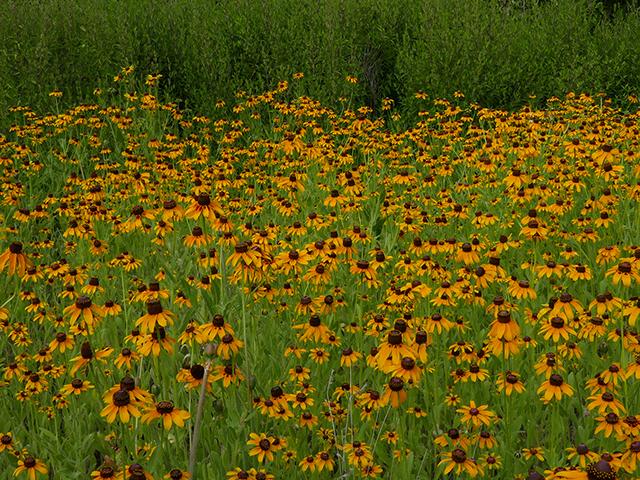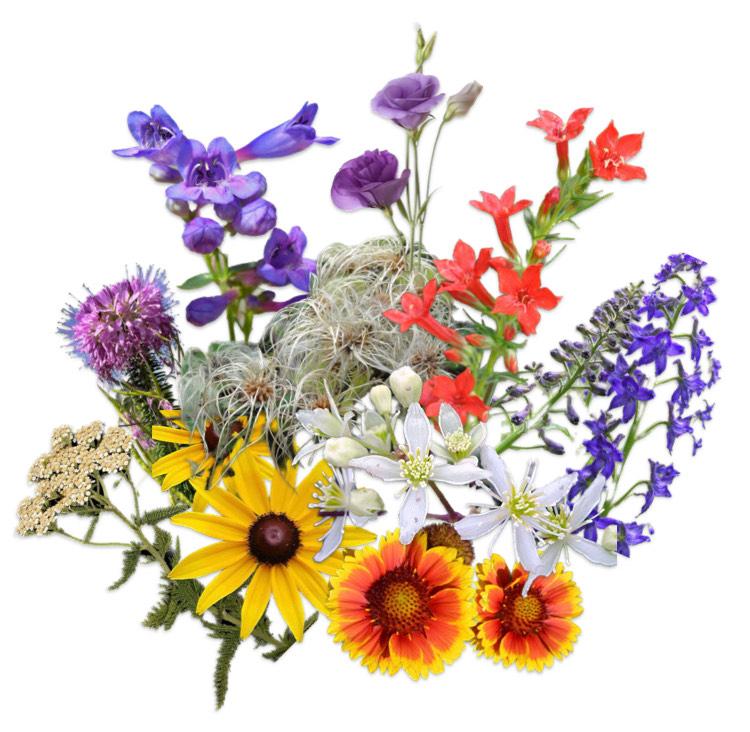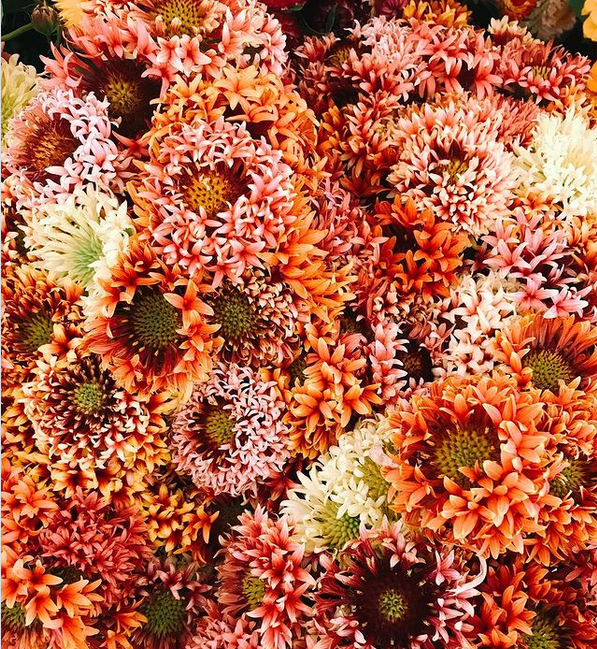By Helen Skiba
Farmer, Artemis Flower Farm
Did you know that many Colorado Wildflowers make great cut flowers? You could plant lots of native Colorado wildflowers in your yard for use in bouquets.
Finding a native plant that also works as a cut flower can be challenging! Cut flowers need to stand up to plenty of stress, especially if they are going into arrangements that will be out of water, in the sun, or worn as a boutonnière or hair adornment.

Let’s start with basic cut flower requirements, native or not. First, consider the stage of the flower’s life. A flower that has already been pollinated has done its job and will quickly senesce or fall off the stalk.This is why cut flower producers do their best to cut flowers early, often before they have opened. For example, snapdragons are cut when only ⅓ of the florets on the stem are open, and we cut sunflowers as soon as petals begin to rise from the disk face. Cutting early gives you much more vase life, and the flowers will be at their peak a day or two later if kept at warmer temperatures. This means you have time to cut and arrange and allow them to open fully before any event.
When should you cut? Always try to cut flowers in the early morning. At this time, they’re full of the water they’ve been drinking overnight, and they’re not releasing moisture to the air, because their stomata are closed. Definitely don’t harvest if temperatures are over 80 degrees. Cut your stems at a 45 degree angle; this gives the flower more surface area through which to drink water, while also keeping it from sitting flat on the bottom of the vase, which might keep it from drinking. Cut a nice long stem: you might need it. Once you’ve cut the flower, strip any foliage off that will be underwater. This prevents rotting leaves in your arrangement and prolongs the flower’s vase life, while also making more room for stems in the vase.
Get the flower directly in water as soon as possible! The more time the cut end is out in our dry Colorado air, the more likely the pores of the plant’s xylem are to close and scab over, making it impossible for the flower to drink. Your water, vases, and buckets should be clean enough that you would drink from them. Your shears or snips should be very clean and sharp, too. Sharp shears mean sharp cuts that slice the plant, rather than crushing it, which leads to more entry points for bacteria in the stem. If possible, allow the flowers to sit for at least 3 hours in a cool place before working with them, but overnight is best.
Flowers last longer in cool, dark places. My commercial cooler is kept at a chilly 36 degrees and most flowers love it. If you’re not using your flowers right away, a basement or garage fridge, with the temperature turned up slightly, can work wonders, or put the flowers in that one really cold closet in the house. Beware that some flowers will not like this treatment: zinnias & basil come to mind.
The other way to prolong a flower’s life is to keep its water clean and fresh. The reason flowers begin to wilt (besides just the fact that they’ve been beheaded and not many creatures can tolerate that for very long) is that bacteria begin to grow on the stem and clog the vascular tissues. If you can keep the stems and water free of bacteria, you’ll get longer vase life.
You do not need to give your flowers food. The best thing for them is very clean water. Most commercial flower foods contain three things: a biocide, an acidifier, and sugar. The biocide, often chlorine, prevents bacterial growth. The acidifier helps the plant drink more and opens its xylem pathways. Sugar continues to feed the plant, and is said to keep colors more vibrant. If you wanted to make your own plant food, you could try a drop of bleach, lemon juice or vinegar, and a bit of dissolved sugar. The only thing I’ve ever used is a drop of bleach in each 5-gallon bucket I harvest into. This works really well and allows me to hold flowers in the cooler for weeks. If you avoid bleach, try hydrogen peroxide – you’ll have to add more to get the same effects.To get the best life out of any arrangement, change the water daily, and re-cut the stems if you see them shriveling or getting mushy.
Now that you know how to treat your flowers, which flowers should you use? I found this question hard to answer! There are so many suitable flowers that already exist in your landscapes that I’m sure I couldn’t address them all. But all you really have to do is test them to see if they work. To test flowers, adventurous florists offer the following kinds of challenges to new flowers:
In water test:
Does the flower withstand being cut and placed in water at room temperature? For how many days does it still look presentable?
Out of water test:
Simply set the flower on a table out of water, and out of direct sunlight. Can it handle it? How many hours until it’s very very droopy? Flowers that can last more than 5 hours in this state are candidates for out-of-water applications like boutonnières or flower crowns.
Hydration chamber:
If flowers don’t perform as well as you’d like in the out-of-water test, try treating a new specimen in a hydration chamber and re-testing. A hydration chamber is simply an airtight box, like a Tupperware container, lined with moist paper towels. Place the flower in here for 6ish hours, and then repeat the test. Does the flower hold up longer? The theory is that the plant will imbibe water through all its tissues, not only the stem, plumping it and allowing it to hold up out of water much longer.
But here are my suggestions for native flowers that work well as cuts:

Rudbeckia hirta (Black-eyed susan): These sunny ladies are wonderful, happy additions to bouquets. Their stems are hairy, which can lead to more bacteria build up. They can also be wilty, especially in direct sunlight. Harvest before the anthers on the central cone have begun to appear, and when the petals are more upright than parallel to the ground.
Lisianthus (Prairie gentian): While the hybridized varieties most commonly used by florists may not really be natives anymore, this is an excellent cut flower, lasting for weeks in the vase and days out of water. A true gem. Cut it before it starts to make pollen and you’ll have a winner.
Achillea (Yarrow): This old standby is a fantastic cut and a great dried flower, too. Cut it after it starts to make pollen, or it will wilt on you.
Gaillardia (Blanket flower): I am such a fan of these! My favorite variety is ‘Lorenziana’, a double-flowering variety available through Wild Garden Seeds. Cut it early, before it starts to make the ball-shaped seed head in the middle.
Helianthus (Sunflower): Colorado classic! These have hairy stems like rudbeckia, so keep an eye on their water or add bleach. Cut them as the petals are pulling away from the central disk, or at least before they start putting out their anthers. The pollen can be a nuisance.
Larkspurs: A huge favorite of mine. Go for stems that haven’t fully opened to the top; harvested at this stage, they can last a long time, and the little spurred buds can be great additions to glued floral art like corsages or crowns. Plus, you can’t go without that true blue color.
Cleome (Rocky Mountain Bee Plant): I grew these for cuts last season and really loved them – they’re so unusual and intricate. They’re hard to cut on time, as the lower florets senesce before the top of the inflorescence really gets going, but you can always strip off any browning florets down the stem. They can be spiny, and they’re also sticky, so beware!
Ipsomompsis aggregata (Scarlet gilia): I’ve not tried this as a cut myself, but its stunning red color makes it worth a test or two. Again, harvest as the lower part of the stem is opening, hopefully before too many pollinators get their fill.
Clematis virginiana: I’ve often used this for draping bouquets, wrapping arbors, and informal flower crowns. I think it would benefit from a hydration chamber treatment. Try to cut it before all the flowers are open – the little round buds make it even more beautiful. In the fall, I adore the wispy pinwheel-like seed pods.
Penstemons: These succulent plants are wonderful cut flowers that do great in water, though I’ve not tried them much. Again, with spike flowers, cut when the lower third or half is open.
Please reach out if I can answer any more questions! [email protected]

Artemis Flower Farm is an ecology-focused flower farm between Boulder & Longmont. We grow specialty cut flowers for florists, brides, and lovers of beauty. We offer on-farm gardening and floral design workshops, bouquet subscriptions, wedding design, and much more. You can find out more about us at www.artemisflowerfarm.com
Curious to learn more about transforming your garden into a habitat with Colorado native wildflowers, grasses, shrubs, and trees? Check out our native gardening toolkit, register for an upcoming event, subscribe to our newsletter, and/or become a member – if you’re not one already!
